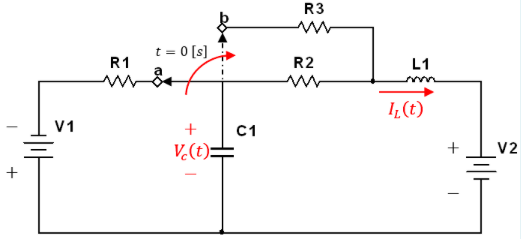¡Tu solución está lista!
Nuestra ayuda de expertos desglosó tu problema en una solución confiable y fácil de entender.
Mira la respuestaMira la respuesta done loadingPregunta: Para el circuito mostrado en la figura siguiente, el interruptor cambia de la posición a hacia la posición b en t=0 [s]. Para t<0 [s] considere que el interruptor estuvo en la posición a durante mucho tiempo. For the circuit shown in the next figure, the switch changes from positon A to position B in t=0. Para t<0(s) consider that the switch was in position
Para el circuito mostrado en la figura siguiente, el interruptor cambia de la posición a hacia la posición b en t=0 [s]. Para t<0 [s] considere que el interruptor estuvo en la posición a durante mucho tiempo.
For the circuit shown in the next figure, the switch changes from positon A to position B in t=0.
Para t<0(s) consider that the switch was in position A for a long time.
R1= 1384 Ω ; R2= 2368 Ω, R3= 1000 Ω ;C= 7.8525E-7 F ;L= 0.5 H
V1= 40 V ; V2= 20 V
a) Determine las condiciones iniciales tanto para el capacitor como el inductor para t<0 [s].
a) Determine the initial conditions for the capacitor and the inductor for t <0 [s].
¿Cuál es el valor inicial de Vc(0)?
What is the initial value of Vc (0)?
¿Cuál es el valor inicial de dVc(0)/dt y iL(0) ?
What is the initial value of dVc (0) / dt and iL (0)?
B) Determine la ecuación diferencial respecto al Vc(t) para t>0 [s].
B) Determine the differential equation with respect to Vc (t) for t> 0 [s].
Exprese la ecuación diferencial de la siguiente forma:
Express the differential equation as follows:
¿Cuál es el valor de P1, P2, P3 ?
What is the value of P1, P2, P3?
C) Determine los siguientes parámetros del circuito.
C) Determine the following circuit parameters
¿Cuál es el valor del factor de amortiguamiento del circuito?What is the value of the damping factor of the circuit?
¿Cuál es el valor de la frecuencia de resonancia del circuito?
What is the value of the resonant frequency of the circuit?
D) Qué tipo de respuesta posee el voltaje Vc(t) para t>0 [s]?
D)What kind of response does the voltage Vc (t) have for t> 0 [s]?
Sobre-amortiguado, críticamente amortiguado, infra-amortiguado o sin pérdidas
Over-damped, critically damped, under-damped or lossless
E) Cuál es la solución particular de Vc(t) t>0 [s]
E) What is the particular solution of Vc (t) t> 0 [s]
F) ¿Cuál es el valor de la constante Nº 1 (K) de su solución Vc(t)?
F) What is the value of constant N°1 (K) of your solution Vc (t)?
La constante Nº 1, K es igual a: ___
The constant No. 1, K is equal to:
¿Cuál es el valor de la constante Nº 2 (ángulo) de su solución Vc(t)?
What is the value of the constant N°2 (angle) of your solution Vc (t)?
La constante Nº 2, la constante ángulo es igual a: ___
The constant N°2, the constant angle is equal to: ___
- Esta es la mejor manera de resolver el problema.Solución

Estudia mejor, ¡ahora en español!
Entiende todos los problemas con explicaciones al instante y pasos fáciles de aprender de la mano de expertos reales.


